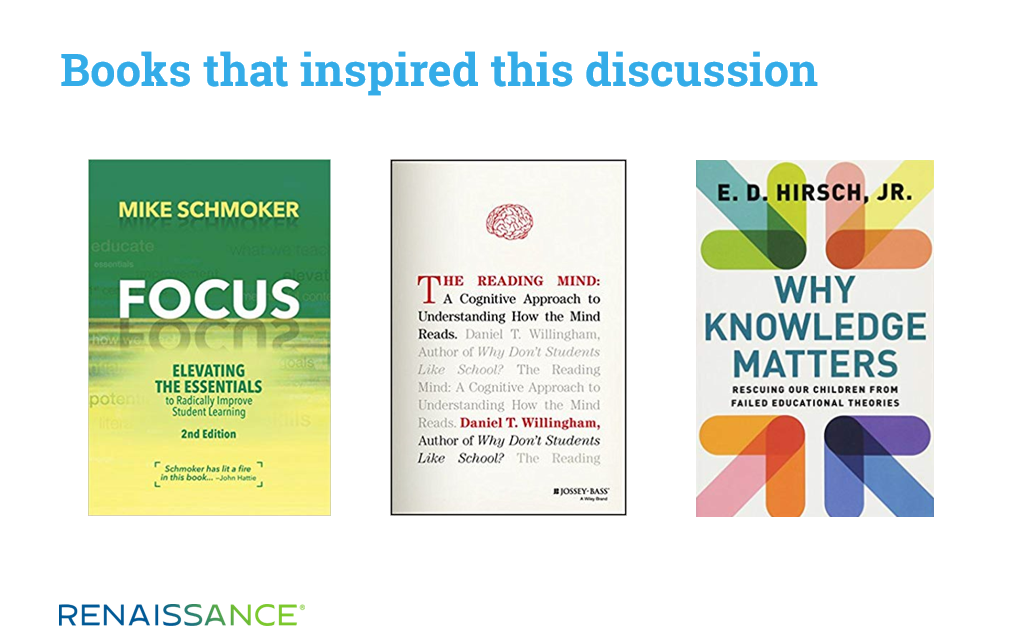November 6, 2020
Emerson wrote that “The mind, once stretched by a new idea, never returns to its original dimensions.” For me, this is the case when I read particularly insightful books. The publication of my new book, Literacy Reframed, would never have happened if my mind had not been “stretched” by the ideas in Focus (2018) by Mike Schmoker, The Reading Mind (2017) by Daniel Willingham, and Why Knowledge Matters (2016) by E. D. Hirsch.
Within great books, there’s sometimes a phrase or central idea that is so crucial that you find yourself coming back to it again and again. It’s like a refrain that offers a particularly important insight. For me, the central idea I kept coming back to is a statement that Schmoker makes in Focus: “After one has learned the mechanics of reading, growth depends, more than anything, on our ability to build up students’ knowledge base and vocabulary.”
After reading countless books and articles about literacy, and after having my mind stretched to larger dimensions, it was this statement that provided a powerful insight.
On a basic level, Schmoker is arguing for additional attention on building students’ knowledge and vocabulary. But as I struggled to reconcile the ideas of multiple authors and the tensions of the “reading wars” that, on some level, continue today alongside the new interest in “the science of reading,” it was Schmoker’s qualifier of “after one has learned the mechanics of reading…” that struck me the most.
Through the extensive reading and writing that it took to produce Literacy Reframed, I have come to envision literacy acquisition as having two district phases—before students have learned the mechanics of reading and after they have learned this.
While this may seem simple at first, it is not. We must draw out and make clear that these are two drastically different phases. What works in one may not work in the other, and what is true in one may not hold true in the other. What our students need from us varies substantially between these two. I’ll refer to them and Phase 1 and Phase 2 of literacy acquisition.

Phonics, the unquestionable first step
Phase 1 is the place for the crucial, explicit, and systematic instruction around phonics that the vast majority of students require for ultimate success. Proponents of phonics will feel completely at home here. Share (1995) notes that phonics instruction represents “the logical point of entry, since it offers a minimum number of rules with the maximum generative power.” As a result, “any plausible model of reading acquisition must assign phonology a leading role” (Share, 1999). Pimentel (2018) suggests that “it is not an overstatement to say that a school that doesn’t have a phonics program is doing its students a huge disservice.”
As much as Willingham and Hirsch want to highlight other critical elements necessary for optimal literacy acquisition, they also view the increased emphasis on solid phonics instruction as a recent and key improvement in our literacy efforts. Hirsch (2016), for example, remarks that “testing regimens have clearly helped improve the mechanics of early reading,” which he views as “an important gain.”
Becoming fully literate is, however, analogous to taking a long journey. Assume that getting there requires a flight, and that the first step in getting to the airport requires leaving your driveway and turning right. Phonics instruction is that first right turn. It’s the correct, most efficient first step, but there’s much more to the journey than this.
Why phonics can only take students so far
Relying solely on phonics to read has obvious drawbacks. First, it’s exhausting. Having to decode many unknown words requires so much processing power that comprehension becomes impossible.
Nearly every educator has observed a student expend so much energy on “sounding out the words” of a text that, at the end of the process, the student has read all the words aloud but is unable to answer the most basic questions about the text’s meaning. When this happens, the fluency of the reading process has been halted beyond repair or synthesis. Readers have finite processing power, and if decoding the words takes most of this power, they have nothing left over to take in what they read. As “overtrained readers, [teachers] no longer have much perspective on how difficult reading really is,” but for developing readers, the difficulty is real (Dehaene, 2009).
Next, for phonics to be instantly helpful in terms of comprehension, readers must already know the meaning of the word they are sounding out. If you sound out a word and have never heard it before, you are no closer to understanding it. As Dehaene (2009) notes, readers do develop the capacity for self-teaching, eventually gaining the ability to “decipher the pronunciation of a novel string and associate it with a familiar meaning,” but this capacity takes time to build. This is why reading to students daily and exposing them to language and text are such critical factors.
Finally, relying on phonics is not what advanced readers are generally doing. To be clear, when they encounter a completely unknown word, advanced readers do revert to phonics, but the vast majority of the time, they are recognizing words instantly by sight or through using their knowledge of known words to figure out at least parts of unknown ones.
While literacy acquisition begins with a phase in which teachers directly teach specific skills (such as letter-sound pairings and consonant blends), the second phase of literacy acquisition is one in which the teacher’s role becomes much more secondary. In order for their literacy abilities to continue to grow and flourish, students must become capable of self-teaching (Share, 1995; Share, 1999).
The power of self-teaching
While there are many elements of self-teaching, it’s helpful to consider one of the simplest: the ability to instantly recognize a known word in print. Students may know the sound and meaning of a word, but if they cannot instantly associate its written form with these, then their reading comprehension, rather than being fluent, will be laborious and completely dependent on phonics and decoding.
To be more precise, capable readers recognize and take in the meaning of known words in print—as you are doing right now—in just fifty milliseconds, or 0.05 seconds (Dehaene, 2009). This results in a dynamic where, accounting for the time needed for the eye to move across a page or a screen, most good readers “read from four hundred to five hundred words per minute” (Dehaene, 2009). Dehaene (2009) reminds us, as good readers, “it’s only because these processes have become automatic and unconscious, thanks to years of practice, that we are under the illusion that reading is simple and effortless.”
“The self-teaching hypothesis argues that the process of word recognition will depend primarily on the frequency to which a [reader] has been exposed to a particular word” (Share, 1995). In other words, has the reader seen the word in print enough times that she has developed the ability to recognize it in milliseconds? This is why appreciable amounts of daily independent reading practice are so critical. It is not time spent “just reading.” It’s self-teaching time. Once students have learned the mechanics of reading, for optimal growth they must be exposed to significant amounts of text across all grade levels.
Much more goes on during independent reading than we may have realized. Beyond building the ability to recognize more and more words instantly by sight, students also acquire vocabulary at a rate far exceeding what we can teach them directly. Depending on the text, they may also acquire background knowledge, and wide reading fosters both writing and critical thinking skills.
Again, pointing out that literacy acquisition has two distinct phases may not seem groundbreaking, but remember what we noted earlier. Because these two phases are markedly different, what holds true in one may not hold true in the other. As an example, consider this statement made by one state agency using the lens of the science of reading: “Children do not learn to read and write through exposure to print.” This is true in Phase 1, before students have learned the mechanics of reading. However, it does not hold true in Phase 2. After students have learned the mechanics, much of their success is tied to their exposure to text, which we now understand as the opportunity for self-teaching.
An acknowledgment of Phase 2 of literacy acquisition—the self-teaching phase—gives us a way to understand why reading growth flatlines after the late elementary grades for far too many. If we can come to better understand the elements of this phase, we can create conditions in which far more students can teach themselves much of what they need to advance their reading competencies. And it’s critical that we do this urgently because many of our struggling students simply should not be struggling.
The needless tragedy of “garden-variety struggling readers”
Many low performing readers have all the skills and abilities necessary for success, but they fail to flourish because we have not created the conditions for them to do so through self-teaching and wide exposure to print. Share (1995) asserts that, when late elementary school students struggle, they usually fall into one of two categories: (1) students who have specific reading disabilities, or (2) students who are “garden-variety struggling readers.” The sad reality is that our current approach produces a lot of garden-variety struggling readers. They represent the majority of readers who struggle. These students have challenges that “are not primarily attributable to…general intelligence, semantic, or visual processes” (Share, 1995). They have the ability; they just have not had the necessary experiences. They have not been able to self-teach.
The use of the word “reframed” in the title Literacy Reframed is very intentional. Reframing suggests a new perspective. A new frame can draw our attention to things that were always there but remained unnoticed. As the researchers Myracle, Kingsley, and McClellan (2019) conclude, “Alarm bells are ringing—as they should be—because we’ve gotten some big things wrong: Research has documented what works to get kids to read, yet those evidence-based reading practices appear to be missing from most classrooms.” If we are to have high levels of literacy for our population as a whole, then literacy must be reframed.
In our next blog, my co-author will look at how literacy is being reframed as we transition from print to digital reading—a process that’s rapidly accelerating due to COVID-19, given that many students do not have regular access to school libraries. As Willingham explains, the mechanics of reading do not change when we move from print to digital. However, our habits of reading often do change, and educators need to thoughtfully consider how to foster the very best reading habits when texts are accessed digitally.
References
Dehaene, S. (2009). Reading in the brain: The new science of how we read. New York: Penguin.
Hirsch, E.D. (2016). Why knowledge matters: Rescuing our children from failed education theories. Cambridge, MA: Harvard Education Press.
Myracle, J., Kingsley, B., & McClellan, R. (2019). We have a national reading crisis. Retrieved from: www.edweek.org/ew/articles/2019/03/07/we-have-a-national-reading-crisis.html
Pimentel, S. (2018). Why doesn’t every teacher know the research on reading instruction? Retrieved from: www.edweek.org/ew/articles/2018/10/29/why-doesnt-every-teacher-know-the-research.html
Schmoker, M. (2018). Focus: Elevating the essentials to radically improve student learning. 2nd ed. Alexandria, VA: ASCD.
Share, D. (1995). Phonological recoding and self-teaching: Sine qua non of reading acquisition. Cognition, 55(2), 151–218.
Share, D. (1999). Phonological recoding and orthographic learning: A direct test of the self-teaching hypothesis. Journal of Experimental Child Psychology, 72(2), 95–129.
Willingham, D. (2017). The reading mind: A cognitive approach to understanding how the mind reads. San Francisco: Jossey-Bass.
Take a deeper look at the 3 types of reading practice that are critical to students’ literacy growth. Also, order your copy of Literacy Reframed from the publisher or from your favorite bookseller.


